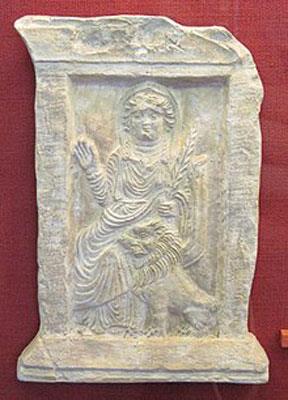Mythologies Of The Past: Discovering Allat, Arabian Goddess Of Resilience, Prosperity
The ancient Greek historian Herodotus mentioned her in his work "Histories" from the 5th century BC, where he equates her with Aphrodite. Allat was often worshipped by travellers who invoked her for protection and favourable weather conditions and booty.
A group of scholars found a small basaltic stone bearing a Safaitic inscription in Wadi Reela Valley in the Black Desert of eastern Jordan. The discovery occurred in 2012 during an epigraphical exploration journey, where epigraphers found hundreds of inscribed basaltic stones decorated with different types of rock art.
"This Arabian text, despite its shortness, leaves open the door of hope to find inscriptions unprecedented in their contents, which enables us to better understand the lives of those communities that lived in the region in terms of their religious beliefs, social life and relationships to their deities," noted the professor Hani Hayajneh from Yarmouk University in Irbid, adding that until the moment this inscription was found, the Ancient North Arabian (ANA) inscriptions did not provide us with evidence of the divinities' testimony / wittiness. However, if the rights of the tribal deity are violated, he/she joins the relatives of the dead man to exact revenge.
According to Hayajneh, the inscription also provides us with further evidence that communities of the ancient Levant and Arabia were cognizant that the concept of 'testimony / witness' is a peculiarity of divinities.
"Perhaps this inscription allows us to return to the assumption that retaliation among the inhabitants of northern Arabia in ancient times was not intended only to uphold tribal rights but to fulfil the rights of the gods and placate them," Hayajneh said, adding that some early scholars opined that life was sacred to the god of the tribe and society, which made them interpret revenge as a religious custom; i.e., it is not permissible to shed blood as the basis of life, except through divine punishment.
In the non-funerary ANA inscriptions, it introduces the text and indicates the person who is the subject of the inscription.
"The author of the present text is affiliated with the widely known and very well attested lineage group. It is only in some texts from late generations that we sometimes find inconsistencies, with genealogy members either missing, or being spelled differently, or their position being exchanged," Hayajneh explained, adding that a translation like "testimony" to the word“sahdt” in the present inscription could be offered; one may assume here that Allat is asked to be the witness of the author's oath of vengeance, or of the act of vengeance itself.
"The presence of the word“sahdt” in a Safaitic inscription from a period much older than Classical Arabic texts invites us to shed light in the development of two nominal derivations, namely sahada' and sahidthat occupy a major role in the history of Arab-Islamic religious thought until today," Hayajneh underscored.

Legal Disclaimer:
MENAFN provides the
information “as is” without warranty of any kind. We do not accept
any responsibility or liability for the accuracy, content, images,
videos, licenses, completeness, legality, or reliability of the information
contained in this article. If you have any complaints or copyright
issues related to this article, kindly contact the provider above.
Most popular stories
Market Research

- Japan Halal Food Market Size To Surpass USD 323.6 Billion By 2033 With A CAGR Of 8.1%
- BTCC Summer Festival 2025 Unites Japan's Web3 Community
- Red Lions Capital And Neovision Launch DIP.Market Following ADGM Regulatory Notification
- Thrivestate Launches“Fly Before You Buy” Program, Enabling International Buyers To Explore Dubai Before Committing
- Quinoa Seeds Market Size To Expand At A CAGR Of 5.5% During 2025-2033
- The Dubai Insiders Club Expands Access To Australia And Asia Amid Surge In International Investor Demand






















Comments
No comment